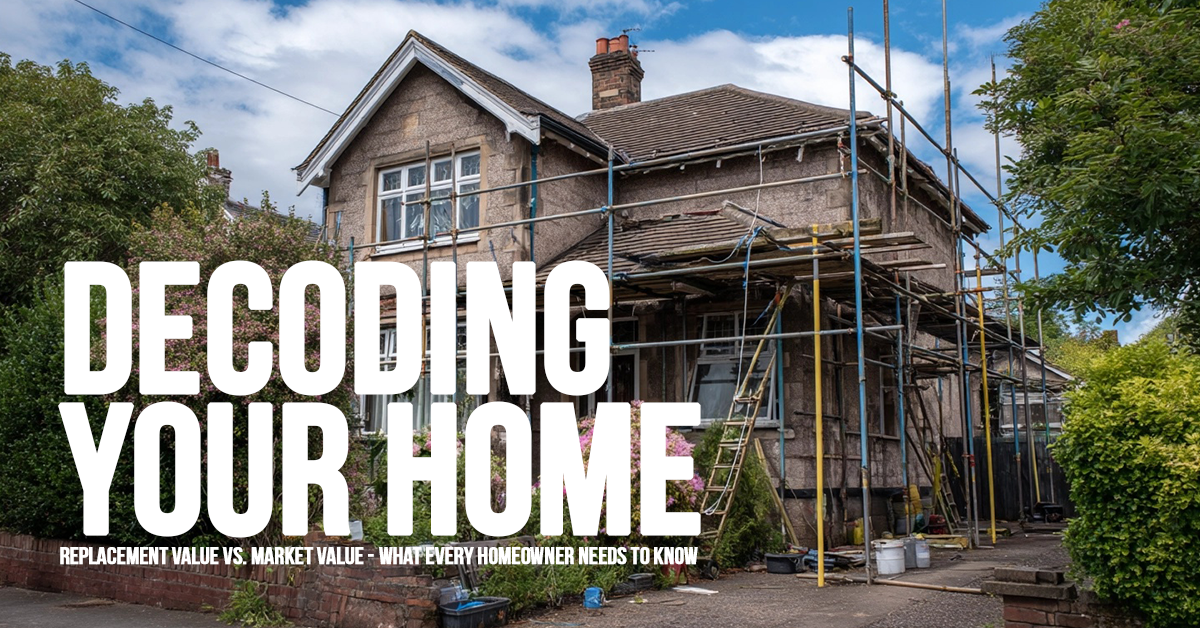Decoding Your Home Insurance: Replacement Value vs. Market Value – What Every Homeowner Needs to Know

Decoding Your Home Insurance: Replacement Value vs. Market Value – What Every Homeowner Needs to Know
For homeowners, navigating the world of insurance can sometimes feel like deciphering a foreign language. Among the many terms and concepts, understanding the distinction between replacement value and market value is absolutely fundamental. It forms one of the core pillars upon which the adequate protection of your home rests. Failing to grasp this difference can lead to significant financialShortfalls in the event of a loss, leaving you vulnerable when you need your insurance the most.
Generally speaking, the market value of your home is heavily influenced by its location. Factors such as neighborhood desirability, school district quality, local amenities, and overall economic conditions play a significant role in determining what a buyer is willing to pay for your property. Consider two identical houses constructed in different areas. One might be situated in a vibrant, up-and-coming neighborhood with high demand, while the other could be located in a depressed urban area with lower property values. Despite being structurally the same, their market values could differ dramatically due solely to their geographical context.
Replacement value, on the other hand, operates on a different principle. It focuses on the cost of rebuilding your home to its current size and specifications using today’s materials and labor costs. While regional variations in construction costs can exist, the replacement value is generally less susceptible to the fluctuations of the real estate market driven by location. To illustrate this, imagine the same 1,500 square foot house, identical in every detail, built on three distinct properties: one in a struggling urban area, one in a flourishing suburb, and one with breathtaking ocean views. The cost of the raw materials (lumber, roofing, plumbing fixtures, etc.) and the labor required for reconstruction would likely be quite similar across all three locations. However, the market values of these three properties would likely be vastly different, primarily due to the desirability and perceived worth of the land itself. Importantly, your homeowners’ insurance policy is designed to help you rebuild the structure, not repurchase the land.
Given this crucial distinction, the overwhelming recommendation from insurance experts is to insure your home for 100% of its replacement value. This ensures that in the unfortunate event of a catastrophic loss – such as a fire, tornado, or other covered peril – you will have the financial means to rebuild your home to its original size and with comparable features. Insuring based solely on market value could leave you significantly underinsured. If your home is destroyed, your insurance payout might only reflect the current selling price of a similar property in your area, which, as we’ve seen, can be lower than the actual cost of rebuilding. This shortfall could force you to make difficult choices, potentially having to build a smaller home, use lower-quality materials, or even face significant out-of-pocket expenses.
One of the inherent challenges with homeowners’ insurance is that it often falls into the realm of “set it and forget it.” Many homeowners purchase a policy when they initially buy their house, and in numerous instances, that’s the last time they give it a second thought – until a claim needs to be filed. Years can pass, and significant changes can occur without the homeowner ever revisiting their coverage. This is precisely why scheduling an occasional homeowners’ insurance review is so critically important.
A policy review serves several vital purposes. Firstly, it refreshes your memory about the specifics of your coverage, ensuring you understand what is and isn’t protected. Secondly, it allows you to identify any potential gaps in your current coverage that may have arisen due to renovations, additions, or changes in your personal circumstances. For example, if you’ve added a significant extension to your home or upgraded to high-end finishes, your original policy’s coverage limits may no longer be adequate to cover the cost of rebuilding. Finally, a review can also uncover potential opportunities for savings. Insurance rates and available discounts can change over time, and a review by an independent agent can help you ensure you’re getting the most competitive price for the coverage you need.
Our team of independent home insurance agents is here to help you navigate these crucial decisions. We can provide you with a no-obligation insurance review and quote, taking the time to explain the difference between replacement value and market value in the context of your specific property. We’ll help you confirm that you have the coverage you believe you have and provide you with an updated quote to ensure your home is adequately protected at a competitive price. Don’t wait until disaster strikes to understand your homeowners’ insurance. Contact us today – we look forward to assisting you in safeguarding your most important investment.
Do you have questions about your insurance? Find an insurance agent near you with our Agent Finder
Search All Blogs
Search All Blogs
Read More Blogs
Tinsel and Tropes: A Cozy Look at Why Classic Christmas Movie Moments Endure
From Zuzu’s petals to the leg lamp: Dive into the nostalgic tropes and timeless comfort of our favorite classic Christmas films.
The Silent Season: Securing Inventory and Operations During Christmas and Year-End Closures
Closing the shop for the holidays? Key business insurance checks for protecting vacant property and high-value inventory from theft and winter damage.
The Most Sustainable Gift: Life Insurance and the Value of Income Continuation Planning
Life insurance ensures the Christmas cheer continues. Practical tips on using income continuation math to calculate the right term policy size for your family.
From Home to Holiday: Securing Your Christmas Road Trip Auto Coverage Checklist
Heading over the river and through the woods? Your Christmas road trip needs an auto insurance checkup, focusing on roadside assistance and UIM coverage.
The Fire Under the Fir: Insuring Against Christmas Tree Calamity and Holiday Fire Risk
Don’t let a dried-out tree ruin Christmas. Essential home insurance tips for fire safety, electrical risk, and candle liability during the holiday season.
Cozying Up: Embracing the Danish Art of Hygge for a Stress-Free December
Banish the December chaos! A simple guide to adopting Hygge—the Danish concept of cozy contentment—for a truly joyful holiday season.
Tinsel, Traffic, and Transactions: Insuring Your Business Against December’s Holiday Rush Risks
Don’t let the holiday rush expose your business. A guide to essential commercial insurance coverages for increased sales, foot traffic, and cyber threats in December.
The Ultimate December Gift: Why Life Insurance is the Most Important Present You’ll Ever Give
Forget the gadgets; life insurance is the real gift of security. A timely look at protecting your family’s future during the season of giving.
Skids, Slush, and Safety: How Your Auto Insurance Navigates the December Driving Nightmare
Essential auto insurance checks and tips for safe, claim-free driving through December’s challenging winter weather and holiday traffic.
Snowed In, Safely Covered: A December Guide to Home Insurance and Winter Preparedness
Don’t let winter woes ruin your holiday cheer. Essential tips on home insurance coverage for snow, ice, and festive accidents.









